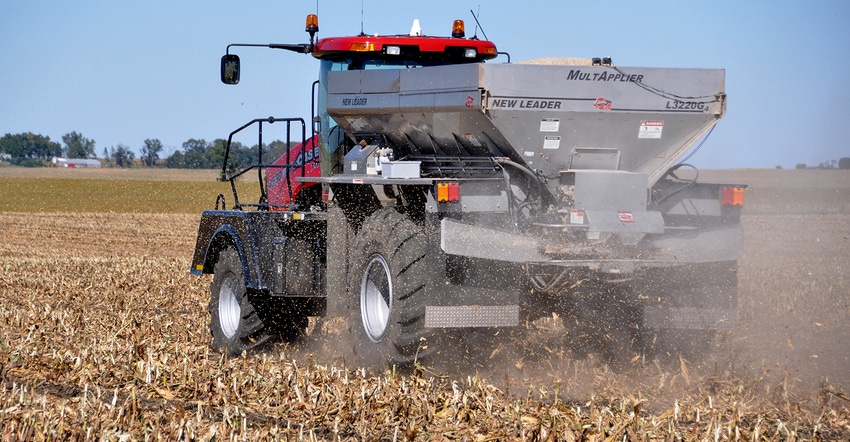August 18, 2017

Soil sample analysis as a crop fertility management tool began soon after the establishment of the first soil testing laboratories in the mid-to-late 1940s and 1950s. The original labs were likely created by and primarily for state university or county Extension services, but were soon expanded to handle the testing of public soil samples.
What is not as easily discernable when trying to understand the origins of the current soil test model is the chronology of events and economic factors that drove the development of these soil labs and ultimately the foundation of the current soil sample-based crop fertility management program that is still in use in modern U.S. agriculture.
Steve Roehl, research analyst for West Central Distribution, has studied the evolution of soil testing and provides the following thoughts and observations.
Development of commercial fertilizer
Shortly after the turn of the 20th century, scientists were discovering chemical processes to produce commercial fertility products. However, it would be the late 1950s to 1960s before these new plant food options would find widespread utility even though it represented a way to amend field-scale nutrient deficiencies without use of leguminous or grass green manures, or hauling and spreading livestock waste or bedding.
The delay between commercial fertilizer manufacturing and mining innovation to eventually implement at the producer level was a lack of transportation logistics to get fertilizer products into the hands of retailers and farmers across the country. Even as a transportation network was being developed to facilitate movement of these commercially manufactured fertilizers deeper into the heartland, there was an additional lag time to fully adopt, as the equipment necessary to accurately apply these fertilizer sources was being created and refined to keep pace with a rapidly expanding agriculture industry.
Testing soil fertility next step
Once these important infrastructural components were put in place, and retailers and farmers had unimpeded access to relatively inexpensive and convenient commercial fertilizer to amend their soil fertility and increase crop yield, the obvious next step was to create a system that could allow for monitoring the current condition of a field or farm to determine the economic return on a fertilizer input investment. This new demand to assess soil fertility at the field level to allow for establishment of economic fertilizer-use rates led to land-grant university and private business research into the current soil analysis model to identify essential nutrient extraction techniques and to correlate nutrient extraction levels from soil samples to a relative plant availability status.
Thus, the current soil test and fertility model used today was created in response to the development and pervasive use of commercial fertilizers over a half a century ago.
Soil sampling, testing helped boost yield
To the model’s credit, if longevity is an indication of the quality of the method, then our current soil-testing analysis and fertilizer remediation model should be considered one of the greatest advancements to agriculture. In fact, there is considerable evidence to support this claim, even allowing for the significant crop genetic advancements that were also being made about this same time.
One example would be the increase in average corn yield in the U.S. In 1950, the average U.S. corn yield was about 40 bushels per acre, whereas it is about 170 bushels per acre today. This relates to an average increase in yield of 20 bushels per acre each decade.
Pressure to develop new sampling model
Regardless of how successful and essential the current soil sample model has been, agronomists and academics alike are recognizing that the model may possess a few limitations that relate to keeping up with the changes that a century of intensive farming can have on soil organic matter, structure and tilth, as well as the changes to equipment, crop genetics and biotechnology. Several scientists are worried that the current model is going to need assistance to keep up with changes and innovation, and are looking toward contemporary research projects aimed at gaining a greater understanding of complicated soil nutrient cycles.
Scientists can then create a new base of data to extrapolate, and predict expected yield responses to specific soil test nutrient levels, in addition to new technology designed to increase plant use of the nutrients that exist in the soil or that are being applied. There is also a strong undercurrent of pressure coming from environmental advocacy groups that are concerned about fertilizer nutrients that are left unused by crops and are finding their way into water sources including lakes, rivers, streams and groundwater.
Next big step in crop yield achievement
U.S. agriculture has its sights set on breaking the average 200-bushel-acre corn yield barrier and achieving 75-bushel-per-acre or better soybean yields by 2030. But is the current fertility model strong enough to support today’s high-yielding hybrids from a crop nutrition perspective or will it need some assistance in the form of technology?
Several prominent soil scientists and crop physiologists will argue that the next big step in crop yield will require an improvement to the current soil sample model to keep pace with all the changes occurring in agriculture in combination with new developments in nutrient application and crop utility technologies designed to improve fertilizer efficiency.
Source: West Central Distribution
You May Also Like




